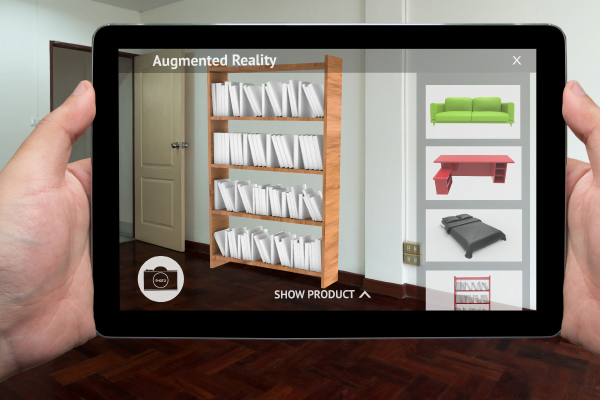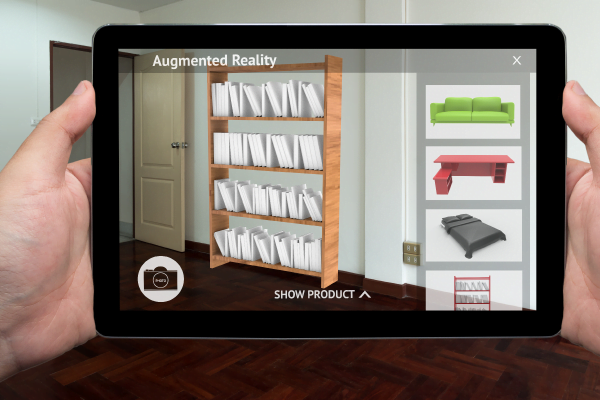Augmented Reality in retail has brought about a revolution that is transforming shopping experiences at a remarkable pace! By incorporating AR in retail, shoppers can now interact with, customize, and engage with products better, allowing them to make more informed purchasing decisions. Imagine waking up to a remarkable surge in sales on your commerce platform! Customers are now 20%-30% more engaged and content with the shopping experience. Not only that, but your business also benefits from increased customer trust, improved brand value, and a better return on investment – thanks to Augmented Reality!
Nike’s Virtual View is a prime example of how WebAR in retail can boost customer engagement and trust. However, investing in new business technology may warrant some distrust at the beginning. Therefore, we present a comprehensive guide on what Augmented Reality is and how your retail and commerce firms can strategically implement and reap the benefits of this exciting technology!
What is Augmented Reality?
Augmented Reality is a technology that adds digital content and information to the real-life environment, improving the virtual experience of the physical world. Using computer-generated visuals, sound, text, and graphics, AR enhances the users’ real-world experience, resulting in an improved version of the physical world. For example, with AR, users can now visually search for things by pointing their mobile cameras at objects in their surroundings. Google Maps’ Live View feature is a prime example of how AR enhances users’ real-world experience by allowing them to visualize their destinations. Although AR is mainly known for its use in gaming and navigation, it has expanded to various industries, including retail and consumer products. Leading e-commerce brands and in-store retailers increasingly invest in AR to create exceptional customer brand experiences. The popularity of AR is evident in the success of applications like Nintendo’s Pokémon Go and Instagram and Snapchat photo filters.
How Does Augmented Reality Work?
Augmented Reality is brought to life by a camera-equipped device with AR software, like a smartphone, tablet, or smart glasses. Once a user points the device camera at an object in the real world, it triggers the experience. The critical difference is that the AR information is presented in a 3-D experience that is superimposed on the object rather than a 2-D page on a screen. The resulting view for the user is part real world and part digital, which provides an incredible experience that merges the virtual and physical worlds.
Why Is Augmented Reality Substantial In Retail and E-commerce?
In today’s world, millennials are the primary shoppers, and they demand services that are easily accessible. They prefer to book items online. With Augmented Reality in Retail, the online shopping experience has taken a new turn. Shoppers can now virtually try on products, customize them, and interact with them to make quick and intelligent purchase decisions. This enhanced experience leads to greater satisfaction with online shopping, significantly increasing brand trust and boosting retailers’ sales.
How is Augmented Reality reinventing the retail world?
Augmented Reality in retail is revolutionizing the industry in several ways. While the traditional retail environment is structured and has a global reach, it has many flaws, particularly during times of crisis. Physical retail markets necessitate personal interaction and costly setup, unlike online stores. Additionally, traditional stores have fixed hours, and products can quickly go out of stock. Immersive experiences are absent in traditional retail markets, and sales depend on the salespeople’s selling skills. Traditional stores often need more customization and can be limited by language barriers, which makes selling to diverse customers difficult. By leveraging AR in retail, businesses can overcome these limitations and provide a shopping experience that is personalized, interactive, and available 24/7. AR in retail can bridge the gap between the digital and physical worlds, resulting in a more engaging and satisfying experience for shoppers.
AR in retail: benefits for retailers
Augmented reality in retail revolutionizes how retailers conduct business, and the benefits are manifold. The application of AR in retail provides businesses with a unique opportunity to increase customer satisfaction while reducing operational expenses.
Expanding sales
One of the most significant advantages of AR technology is that it boosts sales by enabling customers to try out products virtually before making a purchase. Customers can try the products before adding them to the cart, making payments, or requesting delivery. As a result, AR helps reduce the customer journey and increases store conversions, driving more business sales and revenue.
Minimizing returns
Another advantage of AR in retail is that it helps minimize returns. AR allows customers to avoid disappointment by trying out products virtually, ensuring they choose items that suit them best. It helps businesses save money on return logistics and also helps them preserve their reputation and avoid the negative impact of high return rates.
Boosting customer engagement
AR improves customer engagement with its oomph factor. It can present the same product better than an image or a video, thus delivering more engaging information.
Social media engagement
AR in retail enables brands to add extra appeal to their social media strategy. They can create viral-worthy social media content that helps increase product and brand awareness, leading to increased business sales and revenue.
Accumulating data on customer preferences
In addition to these advantages, AR also helps retailers collect valuable data on customers’ interests, preferences, and shopping patterns as they try products in AR before buying. Retailers may use these insights to deliver personalized advertising and marketing campaigns, further boosting sales and customer engagement.
Offering a contactless experience
AR’s applications in retail also eliminate contamination risks and hygiene concerns, making the shopping experience safer and more contactless. Also, AR retail store navigation reduces the need for human assistance, allowing businesses to reduce staffing expenses and improve the overall shopping experience for customers, leading to higher customer loyalty and stronger relationships with brands.
Building customer trust
As businesses continue to embrace AR technology, it is clear that the benefits of AR in retail are vast and varied. From boosting sales to minimizing returns, increasing customer engagement, and building customer loyalty, AR technology is transforming the industry and providing businesses with a unique opportunity to thrive in today’s competitive marketplace.
Use cases for AR in retail

Augmented reality in retail has revolutionized the industry by providing businesses with multiple use cases to increase customer engagement and drive sales. The two primary approaches for implementing Augmented Reality are in-store and out-of-store. In-store AR is experienced through handheld devices, AR glasses, and head-mounted devices. On the other hand, out-of-store AR is experienced via e-commerce mobile or web apps, allowing customers to experience AR from another physical location. Combining both approaches to create an omnichannel strategy is ideal, but not all retailers can afford in-store AR hardware.
Space visualization and virtual tours:
The benefits of using AR in retail are numerous. One such benefit is space visualization and virtual tours. With AR technology, customers can virtually walk through a store or property before physically visiting it. This technology enables customers to experience the store or property, get a feel for it, and learn essential details beforehand. Such technology minimizes customer apprehension and increases their willingness to make a purchase.
Outfit visualization:
Augmented Reality in retail is transforming the industry, offering new ways to visualize and try on products and improving the overall customer experience. One of the challenges in the apparel industry is that customers need help to envision how the clothes they see on the store hangers will look in real life.
AR-enabled try-on:
Fortunately, many augmented reality retail apps, like the ASOS Virtual Catwalk, allow shoppers to see how the clothes will look on models with different body sizes and shapes before deciding to make a purchase. Virtual try-ons, like the Warby Parker eyeglasses retail AR app and Nike’s augmented reality shopping app, Nike Fit, also provide customers with an immersive and interactive shopping experience.
Augmented Reality in the Retail App Store:
In addition to these examples, many other Augmented Reality apps for retail are available on the App Store. For instance, the Magicplan AR-enabled residential property design planner allows customers to visualize how their homes will look after complete renovations. As a shopper, imagine being able to take a virtual stroll through your newly renovated home, envisioning every detail from the comfort of your current abode. Well, with Apple’s world-renowned augmented reality platform, you can do just that! Boasting the largest AR platform in the world, Apple offers hundreds of millions of AR-enabled devices and thousands of apps to choose from, giving you the power to estimate materials and plan your dream renovation project like never before.
From virtual try-ons to space visualization, AR technology offers businesses new opportunities to increase customer satisfaction and reduce expenses. With the rise of AR-enabled devices and the availability of AR apps, it’s easier than ever for you to implement AR in your retail business. As AR continues to evolve, it’s exciting to think about the potential for even more innovative applications in the future. PlugXR Platform is one such solution that can help you seamlessly integrate AR into your retail business and improve KPIs like never before.


6 Comments
I believe other website proprietors should take this web site as an model, very clean and excellent user genial design and style.
It is really a great and useful piece of information.
I’m satisfied that you just shared this helpful info with us.
Please keep us informed like this. Thanks for sharing.
nice article, Virtual Display Of Products at Home is good
article is knowladgable.
intresting aricle.
This article will help the internet users for building up new blog or even a blog from start to end.|